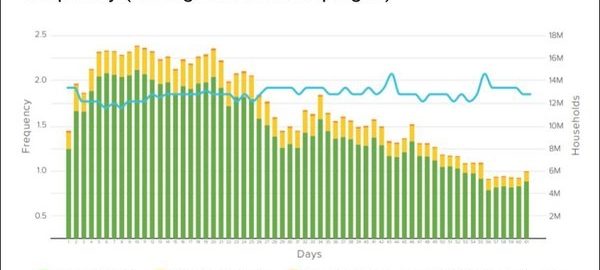Study Across 20 Major Advertisers Finds CTV Frequency Problem ‘Highly Exaggerated’
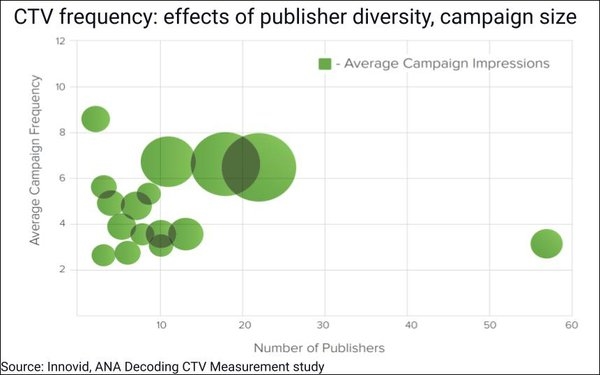
Yes, connected TV is fragmented, and yes, measurement issues continue to be a serious challenge.
But according to a study spanning 35 campaigns from 20 of the world’s largest advertisers, conducted by Innovid and the Association of National Advertisers (ANA), CTV’s much-cited frequency problem is “highly exaggerated.”
Further, both its frequency and duplication rates can be managed, and its pricing can be favorably compared to linear TV when all of its benefits are factored in, says the report, “Decoding CTV Measurement.”
The study used Innovid’s Insights solution to measure 1.75 billion impressions representing more than $35 million in media expenditures, generated between January and April 2021. The campaigns spanned a range of sizes and types, and a mix of programmatic and direct and inventory partners.
Not so surprisingly, it confirmed that advertisers have barely begun to tap CTV’s full potential reach. Across the study, the average campaign used about 47 million impressions across 10 publishers or inventory partners, and reached just 13% of the approximately 75 million unique, addressable U.S. CTV households in the U.S.
The report concludes that brands should put more media weight/impressions behind CTV campaigns, because close to 100 million impressions are required to be allocated to reach at least 40% of the available households.
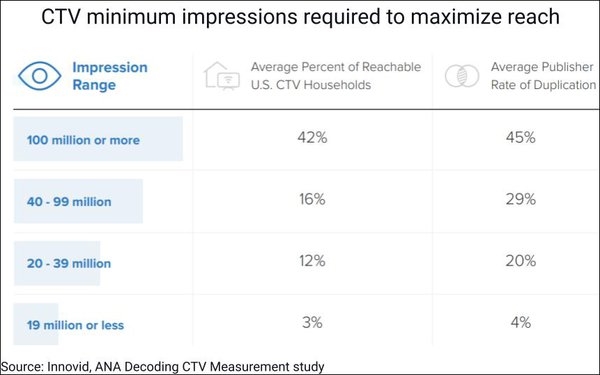
Advertisers leery of CTV’s costs may be somewhat surprised to learn that the study found an average campaign eCPM of $23 — falling between the average CPMs for U.S. primetime TV ads for broadcast ($36) and cable ($19).
That’s moderate, given that CTV can boost return on advertising spend (ROAS) by enabling first- and third-party audience targeting, granular reach, interactivity and frequency measurement at the household level, argues the report. (A previous Innovid study found nearly 40% of advertisers reporting improved ROAS after investing in CTV.)
“All things being equal, if marketers see higher costs for CTV advertising, it’s likely driven by the addition of targeting and other data layers,” the researchers conclude.
The report recommends maximizing CTV’s impact by leveraging programmatic technology to increase unique reach efficiency and reduce costs.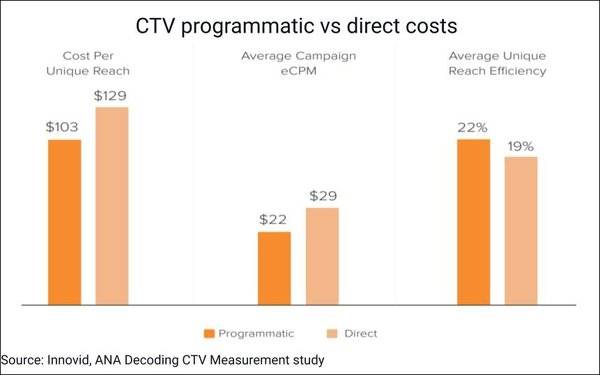
On the duplication front, the study found an average duplication rate of 32% (55% of campaigns averaged overlap of 25% or less, 40% averaged 25% to 50%, and 5% had 51% or higher overlap). In other words, the average publisher’s unique reach percentage was 68%, indicating that most publisher reach was unique from other inventory sources and incremental to the campaign’s total reach.
The takeaways: CTV’s supply-chain fragmentation need not result in excessive duplication levels. It “should be managed, not avoided completely.”
The advice: To achieve scale, marketers should use a combination of inventory types. They should leverage a central platform and evaluate different combinations of media partners and buying methods to identify patterns of duplication and diminishing returns, then monitor rates of duplication at the household level and optimize in-flight or for future campaigns.

As for frequency, the “myth” is that CTV has a problem because the market is relatively small, and supply is driven by excessive frequency.
But the study found a surprisingly low average frequency of 4.6 over the life of the campaigns.
Frequency remained low even as publisher count increased (chart at top of page).
Nor do more impressions necessarily lead to substantial jumps in frequency. Some campaigns with over 100 million impressions had a frequency of about 6, while the campaign with the highest average frequency delivered fewer than 50 million impressions.
On average, 85% of the campaigns had a light frequency, 14% a medium frequency, and just 1% a heavy frequency.
“While it may sound counterintuitive to the headlines about persistent issues with frequency management, this insight provides a compass to mitigating frequency that likely occurs as a response to natural viewing behaviors in specific environments,” say the researchers.
Given that 85% of households were exposed just one or two times, it seems that frequency issues are less about broad saturation than about the likelihood that viewers will be exposed multiple times to an ad when they’re consuming content sold by multiple inventory partners. While it’s common practice for marketers to use weekly frequency caps with individual publishers, viewers with multiple ad-supported video-on-demand services may see content from more than one inventory partner.
And given that capping frequency by publisher in isolation has proven insufficient to manage exposure levels, brands “must manage frequency from a consistent point of origin,” concludes the report. “The reality is that CTV’s frequency issue stems from the fact that the same supply is being sold by different providers. The industry needs a transparent supply chain that supports media planning, buying and measurement use cases.”
Evaluating campaign data through the lens of frequency distribution, duplication rates between sets of publishers, and each publisher’s average frequency by week allows brands to see exactly how impressions are performing and ensure that a campaign’s message isn’t reaching the point of diminishing returns, says the report.
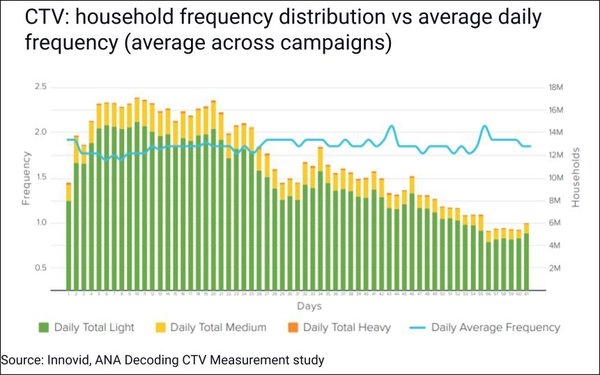
(14)
